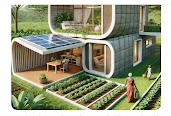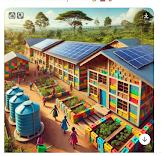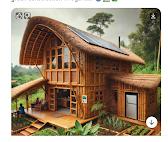The latest trends in sustainable construction.
Sustainable construction is rapidly evolving to address environmental challenges and enhance building efficiency. Key trends shaping the industry include:
- Net-Zero Energy Buildings (NZEB): Achieving structures that produce as much energy as they consume is becoming a standard goal. Advancements in solar panels, geothermal systems, and passive design principles have made net-zero construction more attainable. Greener Ideal
- Use of Bio-Based and Recycled Materials: Incorporating renewable materials like timber and recycled products reduces carbon footprints. For instance, Stockholm’s Wood City project aims to be the world’s largest wooden urban development, emphasizing sustainability and carbon storage.
- Passive Solar Design: Utilizing building orientation, window placement, and thermal mass to harness natural sunlight minimizes reliance on artificial heating and cooling, enhancing energy efficiency. Building Radar
- Smart Glass Technology: Electrometer or “smart” glass adjusts its transparency based on external conditions, reducing the need for heating and air conditioning by controlling solar gain.
- Circular Construction Practices: Emphasizing the reuse and recycling of materials, circular construction reduces waste and promotes sustainability. This approach is gaining traction as the industry seeks to minimize environmental impact. Greener Ideal
- Advanced Insulation Techniques: Innovations like radiant heating and cooling systems, along with improved insulation materials, enhance energy efficiency and occupant comfort.
- Prefabrication and Modular Construction: Building components off-site in controlled environments reduces waste, improves quality, and accelerates construction timelines, contributing to overall sustainability.
- Integration of Renewable Energy Sources: Incorporating solar panels, wind turbines, and other renewable energy technologies into building designs reduces reliance on fossil fuels and decreases operational carbon emissions.Science Direct
These trends reflect a holistic approach to sustainable construction, focusing on environmental responsibility, energy efficiency, and the well-being of occupants.Constructing Sustainable Future
Recent Developments in Sustainable Construction.
- 3D Printing in Construction
- Reduces waste and material costs by precisely printing structures using sustainable materials like recycled concrete.
- Companies are exploring biodegradable and carbon-neutral printing materials.
- Living Buildings & Green Roofs
- Green roofs and walls improve air quality, reduce heat absorption, and enhance biodiversity in urban areas.
- The Living Building Challenge promotes regenerative structures that give back more than they consume.
- Low-Carbon Concrete & Alternative Cement
- Traditional cement production is a major carbon emitter. Innovations like hempcrete, grapheme concrete, and carbon-capturing cement reduce environmental impact.
- AI & IoT for Energy Optimization
- Smart sensors monitor and adjust energy use in real-time, optimizing heating, lighting, and water systems.
- AI-driven digital twins help model energy efficiency before construction begins.
- Water Conservation & Net-Zero Water Buildings
- Rainwater harvesting, Grey water recycling, and water-efficient plumbing reduce water consumption.
- Some buildings aim for net-zero water usage by treating and reusing wastewater on-site.
- Off-Grid & Self-Sustaining Homes
- Off-grid homes integrate solar, wind, and battery storage for energy independence.
- Sustainable tiny homes and Earth ship designs gain popularity for their low environmental impact.
- Mass Timber Construction
- Advanced techniques in cross-laminated timber (CLT) allow for high-rise wooden buildings.
- Reduces reliance on steel and concrete while capturing carbon within the structure.
- Biophilic Design
- Integrates nature into buildings with natural lighting, indoor plants, and water features to enhance well-being.
- Studies show improved mental health and productivity in biophilic environments.
Why Sustainable Construction is growing in Uganda
✅ Affordable Solutions → Eco-bricks, bamboo, and earth blocks make housing cheaper.
✅ Climate Adaptation → Natural cooling, green roofs, and rainwater harvesting help fight climate change.
✅ Energy Independence → solar homes, schools, and hospitals reduce reliance on the power grid.
✅ Waste Reduction → Plastic bricks, waste-to-energy toilets, and recycled materials clean up cities.
The Future of Sustainable Construction in Uganda
Uganda’s population is growing fast, and cities like Kampala need affordable, eco-friendly buildings. With solar power, sustainable materials, and water-saving technologies, Uganda is moving toward a greener, more resilient future.
Here are some visual representations of Uganda’s sustainable construction trends.
- 3D-Printed Housing in Uganda
- Eco Bricks Made from Recycled Plastic
- Solar-Powered Schools & Hospitals
- Bamboo Housing & Green Construction
- Rainwater Harvesting & Waste Recycling
Here is an image of a modern, sustainable 3D-printed house in Uganda with solar panels and eco-friendly design.

Another image showing a school in Uganda built with eco-friendly bricks from recycled plastic, featuring solar panels and a rainwater harvesting system.

Below is an image of a sustainable bamboo house in Uganda, built with locally sourced materials and featuring solar panels for energy efficiency.



